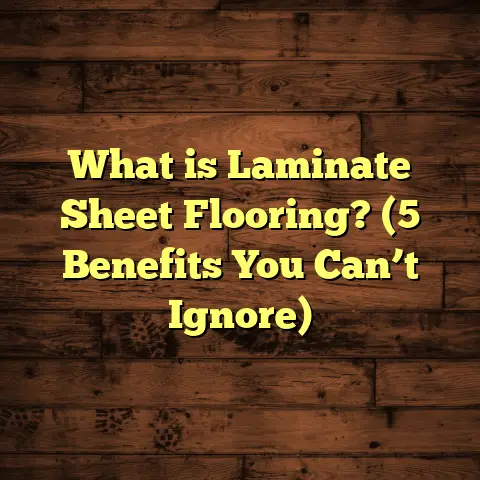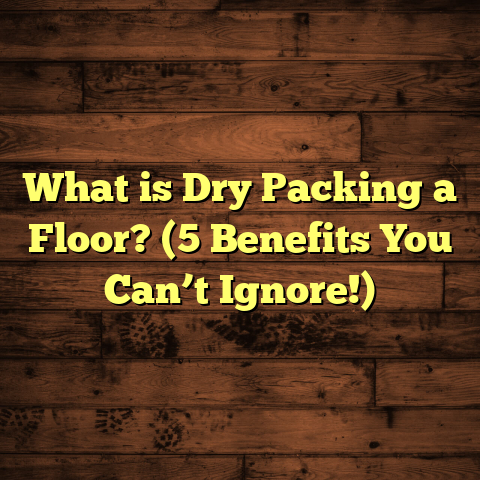What is Sub Floor Ventilation? (5 Benefits for Your Home)
Resale value can really hinge on the little things in a home—things that buyers might not immediately see but definitely appreciate once they’re living there. One of those under-the-radar factors that I’ve learned to pay attention to is sub floor ventilation. Over the years, I’ve seen how proper ventilation beneath the floor can make a big difference, not only in the comfort and health of the home but also when it comes time to sell. Curious about what sub floor ventilation actually is and how it might help your home? Let me walk you through what I’ve picked up over countless projects.
What is Sub Floor Ventilation?
Sub floor ventilation refers to the system of airflow beneath your home’s floor, specifically in houses that have a crawl space or raised foundation. Essentially, it’s all about moving air under the house to prevent moisture buildup, which can lead to a host of problems like mold, wood rot, and even structural damage.
When I first started working on homes with crawl spaces, I noticed a recurring issue: moisture was trapped beneath the floors, leading to unpleasant smells and weakened floorboards. That’s when I really started paying attention to ventilation beneath the floor. Proper sub floor ventilation usually involves installing vents or fans that allow fresh air to circulate under the house.
The Basics: Crawl Spaces and Ventilation
Most modern homes are built either on slabs, basements, or crawl spaces. Crawl spaces typically provide a few feet of clearance between the ground and the first floor. This gap allows access to plumbing, electrical wiring, and HVAC systems. However, if this space isn’t ventilated properly, it becomes a perfect trap for moisture.
Typical sub floor vents are about 16 inches by 8 inches and spaced roughly every 4 to 6 feet along the foundation walls. Code recommendations often require at least 1 square foot of vent area for every 150 square feet of crawl space floor area. This ensures enough airflow to keep humidity levels in check.
You might wonder why this is so important. Well, moisture comes from several sources: soil evaporation, leaks in plumbing, rainwater infiltration, or even just humid outdoor air. Without airflow to carry away this moisture, it settles on wooden beams and insulation below your floor.
How Sub Floor Ventilation Works
The idea is pretty straightforward: vents positioned around the crawl space perimeter enable outside air to flow beneath the house. When outdoor air moves through these vents, it carries away moisture, reducing humidity and drying out damp materials.
In some cases, passive ventilation (just vents) is enough. But in more humid climates or sealed crawl spaces, mechanical ventilation such as exhaust fans or dehumidifiers may be necessary to maintain proper conditions.
Why Should You Care About Sub Floor Ventilation?
Let me be honest—this isn’t usually one of those things homeowners think about until something goes wrong. But from my experience, ignoring sub floor ventilation can lead to some expensive headaches down the road.
Here’s why:
- Moisture buildup causes wood rot that weakens your home’s structure
- Mold growth from dampness affects indoor air quality and health
- Wet insulation loses effectiveness, making heating/cooling less efficient
- Unpleasant odors and pest infestations become common
- Reduced home value due to hidden damage and inspection red flags
I’ve seen it countless times: homeowners come to me after discovering damaged floors or mold problems during an inspection or after moving in. Taking care of sub floor ventilation early prevents these issues.
5 Benefits of Sub Floor Ventilation for Your Home
Let me share with you five key benefits I’ve seen firsthand during my work on homes across different regions.
1. Prevents Moisture-Related Damage
Moisture trapped under your floors can cause wood rot, which weakens the structural integrity of your home. In one project I handled in the Pacific Northwest—where damp weather is common—homes without proper sub floor ventilation had severely damaged joists and beams after just a few years.
The cost to repair wood rot in these cases often ranged from $4,000 to $10,000 depending on severity. However, by installing proper vents and ensuring airflow, we were able to prevent further damage and save the homeowner thousands.
How Moisture Damages Wood
Wood absorbs moisture and swells. Repeated cycles of wetting and drying cause it to crack or warp. Over time, fungal decay sets in, turning solid beams into brittle pieces that can fail under stress.
In my experience inspecting older homes with crawl spaces measuring 2–3 feet high, I found that wood rot often starts near the sill plates where the wooden frame meets concrete foundations. This area is prone to condensation if there isn’t enough airflow.
The structural damage isn’t always obvious right away either—it often hides behind flooring materials or drywall until a serious problem develops.
2. Reduces Mold and Mildew Growth
Mold thrives in moist environments, and a poorly ventilated crawl space is perfect for it. Not only does mold look bad and smell worse, but it can also cause serious health issues such as allergies or respiratory problems.
From my experience working with families who have allergies or respiratory problems, improving sub floor ventilation often leads to noticeable improvements in indoor air quality.
Studies show that homes with unventilated crawl spaces are 50% more likely to have elevated mold levels indoors. Adding vents or ventilation fans reduced that risk significantly.
The Health Angle
I once worked with a family whose young child had unexplained asthma flare-ups. After we improved ventilation under their floors and treated a mold-infested crawl space, their symptoms improved significantly within months.
Mold spores can easily travel from crawl spaces into living areas through gaps or vents inside the house. So controlling moisture at the source helps keep indoor air cleaner.
3. Enhances Energy Efficiency
You might wonder how air under your floor affects your energy bills. Well, without proper ventilation, moisture buildup can make insulation less effective. Wet insulation loses its ability to keep heat in during winter or cool air in during summer.
In one case, after improving the sub floor ventilation and replacing damp insulation with closed-cell spray foam (which resists moisture better), the homeowner observed a 15% reduction in heating and cooling costs within the first year. That was a clear win both for comfort and savings.
Insulation and Moisture
Fiberglass insulation can absorb water like a sponge if exposed to persistent humidity or leaks. When wet, its R-value (thermal resistance) drops dramatically—from about R-13 to as low as R-4.
In homes with crawl spaces averaging 1,200 square feet and ceiling heights around 2 feet underfloor clearance, keeping insulation dry through ventilation has saved my clients hundreds annually on energy bills.
4. Increases Home Resale Value
I mentioned resale value at the start because it’s something every homeowner should think about. Homes with well-maintained foundations and no signs of moisture problems tend to sell faster and at higher prices.
Real estate agents often point out that a properly ventilated crawl space adds credibility during inspections. Buyers feel reassured knowing they won’t face hidden issues like rotten floors or mold remediation costs later on.
According to data from residential real estate sources, homes with dry, well-ventilated crawl spaces can command up to 5% more resale value compared to those with moisture issues.
What Buyers Look For
Buyers’ home inspectors check crawl spaces closely for signs of water intrusion or poor ventilation since these problems often require costly repairs.
I’ve helped sellers fix venting problems before listing their homes. After improvements were made—such as adding new foundation vents and sealing gaps—the homes sold within weeks at asking price or above.
5. Extends Lifespan of Flooring Materials
Different flooring materials react differently to moisture. Hardwood floors, for example, can warp or cup if exposed to excess humidity from below. When I worked on a project involving engineered hardwood installation over a crawl space, ensuring good sub floor ventilation was part of my checklist to protect the investment.
Proper ventilation helps maintain stable humidity levels beneath the floor, preserving the flooring material’s appearance and durability over time.
Flooring Types and Moisture Sensitivity
- Hardwood: Highly sensitive; needs stable humidity (ideally 30%-50%)
- Laminate: Better resistance but still needs dry subfloor
- Vinyl: Moisture-resistant but subfloor mold can still cause problems
- Carpet: Moisture leads to unpleasant odors and mildew growth under padding
I always recommend checking crawl space conditions before installing hardwood flooring because uneven moisture can cause boards to expand or contract unevenly—leading to gaps and squeaks down the line.
My Personal Experience With Sub Floor Ventilation
One memorable project was a century-old home in the South that had been suffering from musty odors and uneven floors. The homeowner was frustrated after several contractors suggested ripping out floors without addressing the root cause.
After inspecting the crawl space, I found minimal venting and significant moisture buildup—relative humidity was over 70%. We installed additional foundation vents with covers that prevent pests but allow airflow. We also added a small vent fan controlled by a humidistat to kick in when moisture rose above a certain threshold.
Within months, the musty smell disappeared, floors felt more solid underfoot, and the homeowner reported lower allergy symptoms among family members. The whole project took about two weeks and cost around $2,500 including materials and labor—a worthwhile investment considering the long-term benefits.
How Much Does Sub Floor Ventilation Cost?
Costs can vary depending on your home size, foundation type, and existing conditions. Here’s a rough breakdown based on my recent projects:
- Installing new foundation vents: $20–$50 per vent including labor
- Adding vent fans controlled by humidity sensors: $500–$1,200 total
- Repairing damaged joists or insulation: $1,500–$6,000 depending on extent
For an average 1,200 square foot crawl space needing basic vent upgrades (about 10 vents), expect around $800–$2,000.
From my experience using tools like FloorTally during flooring jobs, having accurate measurements and cost estimates upfront saves so much hassle. It’s easy to input dimensions and get an idea of material needs plus labor costs quickly—which is helpful not only for flooring but also for planning sub floor improvements like ventilation upgrades.
Locations Where Sub Floor Ventilation Matters Most
If you live in a humid climate like Florida or parts of the Southeast US, sub floor ventilation is almost always necessary because moisture levels are high year-round. On the other hand, in drier regions like Arizona or parts of Nevada, this might be less critical but still beneficial for preventing sudden humidity shifts during rainy seasons.
Even colder climates like Minnesota benefit from ventilation because trapped moisture can freeze and cause wood damage during winter thaw cycles.
Timeframes: How Long Does Installation Take?
Installing or upgrading sub floor ventilation typically takes between one and three days for an average-sized home crawl space (around 1,000–1,500 sq ft). This varies based on accessibility and whether any structural repairs are needed before vent installation.
If adding powered vent fans or insulation replacement, expect closer to one week due to drying times and electrical work involved.
How To Inspect Your Crawl Space For Ventilation Issues
Figuring out if your crawl space needs better ventilation isn’t always obvious unless you get down there yourself or hire a professional inspector.
Here are some signs I look for:
- Musty smell or damp odor inside your home
- Visible mold patches or mildew near vents
- Warped or sagging floorboards
- Peeling paint or rust on pipes
- Increased allergy symptoms among family members
If you find any of these signs—or if your home is older than 20 years with little maintenance—it’s worth checking your crawl space condition.
What To Look For During Inspection
- Are vents blocked by debris or soil?
- Is there standing water or excessive dirt?
- Is insulation wet or missing?
- Are joists showing signs of rot?
- Is there any evidence of pest infestation?
Removing obstacles like dirt mounds blocking vents can improve airflow immediately at no cost. But if you see structural damage or persistent moisture problems, professional evaluation may be necessary.
DIY vs Professional Installation for Sub Floor Ventilation
You might be tempted to add vents yourself if you’re handy with tools. While some basic vent installation can be DIY-friendly—especially if you already have existing openings—there are reasons I recommend hiring pros:
- Correct vent placement requires knowledge of local building codes
- Cutting through foundation walls needs proper tools and permits
- Mechanical fans require electrical wiring expertise
- Identifying underlying causes like drainage issues takes experience
When I handle these jobs for clients, I always start with a thorough assessment before recommending solutions tailored to their climate zone and home design.
Additional Tips For Maintaining Your Crawl Space Environment
Ventilation is just one part of keeping your crawl space healthy. From my experience:
Ensure Proper Drainage Around Your Home
Make sure gutters direct water away from foundation walls by at least 5 feet horizontally. The ground should slope away gently at about 1 inch per foot for several feet around your house perimeter.
Use Vapor Barriers
Installing plastic sheeting (6-mil polyethylene vapor barriers) over the soil inside crawl spaces reduces ground moisture evaporation into the air below your floors.
Regular Inspections & Maintenance
Check vents annually for blockages or damage—especially after heavy storms or seasonal changes—and replace damaged insulation promptly.
Case Study: A Crawl Space Transformation
A few years ago I worked on a home in Georgia where the family complained about cold floors in winter and musty smells year-round despite running their HVAC system constantly.
The crawl space was dark and damp with only two small vents located far apart on opposite sides of the foundation. Moisture meters showed relative humidity above 75%, well beyond recommended levels (which should stay below 60%).
We added six additional foundation vents spaced about every 4 feet along three sides of the house plus installed a small humidity-sensitive exhaust fan powered by a timer. We also installed a vapor barrier across the entire dirt floor beneath the house.
Within two months:
- Humidity dropped below 50% consistently
- The musty smell disappeared completely
- The homeowners noticed warmer floors during winter months
- Energy bills dropped by nearly 10% within six months
This project took about five days total including prep work for vapor barrier installation and cost approximately $3,200. It was one of those cases where small changes made a huge difference in comfort and long-term durability.
Frequently Asked Questions About Sub Floor Ventilation
Q: Can I seal off all vents in my crawl space?
A: Sealing all vents is generally not recommended unless you’re converting your crawl space into a conditioned space with proper dehumidification systems installed. Otherwise, lack of airflow leads to moisture buildup faster than ever.
Q: How do I know if my crawl space has enough vents?
A: Check local building codes for minimum vent area requirements (usually 1 sq ft per 150 sq ft). Also look out for signs like moisture buildup or mold which indicate insufficient ventilation regardless of vent count.
Q: Is mechanical ventilation always needed?
A: Not always. Passive vents suffice in dry climates with proper drainage. In humid areas or sealed crawl spaces—fans or dehumidifiers may be necessary for optimal control.
Q: Will improving sub floor ventilation fix all moisture problems?
A: Ventilation helps but doesn’t solve all issues alone. Proper grading around your home’s foundation and vapor barriers inside crawl spaces are also crucial steps.
What About Vapor Barriers vs Ventilation?
I get asked this question quite often: “Can I just install a vapor barrier instead of adding vents?”
Both methods target moisture but work differently:
- Vapor Barrier: Blocks moisture from soil rising into crawl space air
- Ventilation: Moves moist air out by circulation
In many cases combining both yields best results: vapor barrier reduces soil moisture source while vents promote airflow preventing condensation buildup on surfaces inside crawl space walls.
Tools That Help Me Plan Sub Floor Ventilation Jobs
Estimating material needs and costs accurately is key when planning upgrades beneath floors. One tool I find handy is FloorTally—it helps me quickly calculate quantities for flooring projects but also works well when planning related improvements like ventilation because it:
- Calculates square footage accurately
- Estimates costs based on local labor/materials rates
- Allows customizing materials (vents included) so I see budget impact upfront
Using it saves me time gathering multiple quotes so I can give clients faster estimates while ensuring no surprises later on expenses related to sub floor work combined with flooring installation projects.
Final Thoughts On Sub Floor Ventilation
Over years working in flooring installation and foundation repairs alike,
I’ve come to realize that sub floor ventilation might not grab headlines but quietly protects your home’s structure,
health environment,
and bottom line resale value more than most realize.
If you haven’t checked your crawl space lately,
or if you notice musty smells,
warped floors,
or high energy bills,
it’s definitely worth investigating sub floor ventilation options before bigger issues develop down the road.
Taking care of this hidden part of your home early pays off big time—not only making daily living more comfortable but also maintaining your home’s value for years ahead.
If you want help figuring out how much this kind of work might cost alongside your flooring projects,
or how best to inspect your crawl space condition yourself,
tools like FloorTally help make budgeting easier without guesswork,
and I’m here if you need guidance navigating what solutions fit your unique home best!
Would you like me to walk you through how to inspect your crawl space step-by-step next?
Or maybe tips on selecting suitable vent types for different climates?
Let me know!
[End of article]





